|
February 2006
Snowdrops by Sandy Leven
The days are getting longer and the snowdrops are appearing. The Galanthus plicatus x nivalis hybrid from Angus is better than ever. There are three flowering bulbs, one with two stems. The flowers are large, much bigger that 'Augustus' which is just starting to open. I am pleased with myself because last autumn managed to re-pot all my snowdrops.
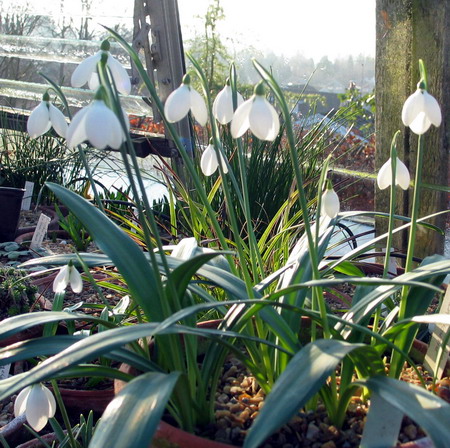
Galanthus plicatus x nivalis
Most people grow their snowdrops in their garden but when I plant them out they do not thrive. I blame the cold heavy clay which is ever present, even though I mulch with homemade compost and lots of bark. Both appear to be well composted, indeed B&Q print 'Composted Bark' on the bales. Another reason for growing snowdrops in pots is that I can see them in easily the frames and alpine house. I am able to take then to the SRGC Early Bulb Display in Dunblane on the 18t February. Some have yet to show above the gravel; some are poking their noses through; some look like white tipped spears and the earliest are in flower. 'Augustus' is always one of the first.
When the snowdrops are in pots it is easier to see small differences between them. I love the yellow form of the common snowdrop, Galanthus nivalis sandersii.
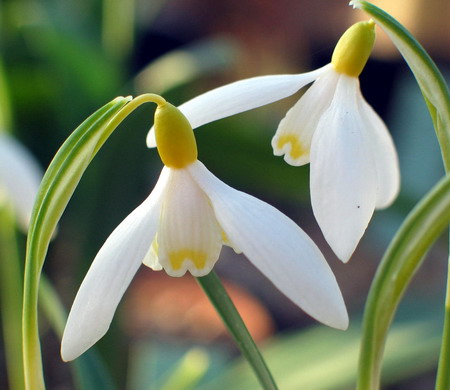
Galanthus nivalis sandersii
Stirling University & Airthrey Castle & a Whale
I was reminded that spring is on the way when I saw the clumps of Galanthus nivalis flowering amongst the coniferous plantings in Stirling University. These had obviously been planted relatively recently but no shame to them for that. Further round the campus where mature woods bound the Northern border of the grounds there are lots of snowdrops which look more 'natural'
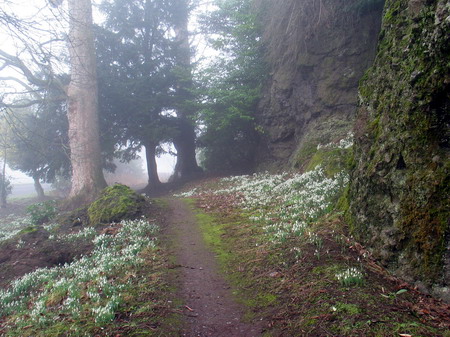
Snowdrops at Stirling University in a natural rock garden
How lucky we in Stirling, Bridge of Allan and Dunblane are, that we are able to stroll round the 'University loch' [Airthrey Loch] when the higher hills are a bit too hostile. Often the path round the loch is muddy but at present it is firm and dry, showing just what a relatively dry month January has been. At the edge of the water the velvety brown heads on the bull rushes were head high. The leaves and stems were 'dead' but in the rays of the late afternoon sun were tinged with gold. One end of the loch was studded with seagulls, each pretending to be a white duck. Amongst the gulls Mallards and Coots paddled in convoys. A few swans added class to the scene.
Stirling University occupies the grounds of Airthrey Castle which 'was built in 1791 to a design by Robert Adam (1728 - 92) for the evangelist Robert Haldane (1764 - 1842)'. An old manor house on the site once belonged to the Grahams of Montrose and in 1645 was burned to the ground by the Marquis of Argyll because Montrose had burned his Castle Campbell at Dollar. Robert Haldane improved the estate, created the loch and landscaped the grounds before selling the estate in 1798. Haldane improved the grounds and had the loch excavated.
The loch is still fed by water from Sherrifmuir up in the Ochil Hills. All those years ago, a lade was constructed to take some water from a burn up near the Sherrifmuir Inn. The lade is about 3 feet wide runs with a very slight gradient along miles of hillside until it runs down to the loch. This wonderful piece of engineering is mostly unappreciated but must have needed great skill and precision in its construction.
A haha is a ditch with a high side which kept animals out of the parkland polices but which was invisible from inside.
'The George Forrest Walk'.
'The George Forrest Walk' parallels the north side of the loch. In large beds beside the path and beside the loch, many species which George Forrest brought back from China were planted. There are many rhododendrons, Pieris forrestii of course and several herbaceous plants and lilies. The university is self sufficient in wood and is cutting down some trees near the entrance. This winter the beds are being re-edged with these tree trunks to replace the original edging. Some plants have died but the majority have matured into fine specimens. There are enough to let us appreciate the diversity of species collected by that great man. Just to see his name on the plaque kindles the spark which links the SRGC and Stirling University for me. It must be the most beautiful campus in the UK.
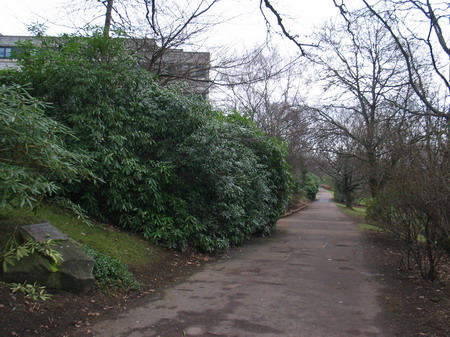
The George Forrest Walk edged with tree trunks.
Note how the trunks are pinned to the ground with fence wire to stop them rolling away from the edge.
Ancient oaks still stand where they were planted nearly 200 years ago. It's no wonder branches drop off them! In 1798 Sir Robert Abercromby bought the estate. He developed it and the surrounding area. Abercromby discovered an ancient whale's skeleton at Airthrey in 1819 (the seashore had originally run along the base of the Ochil Hills). That skeleton went to the Natural History Museum at Edinburgh University. So here in these beautiful grounds George Forrest's legacy is linked to late January's current events. The poor whale which decided to swim up the Thames, perhaps on her way to Kew Gardens for all anyone really knows, may end up in an English museum.
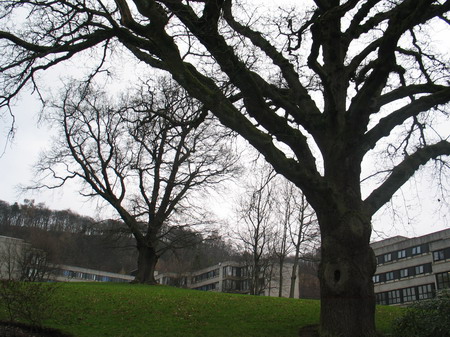
Ancient oak trees in Stirling university grounds
When I start my next project in my garden I hope I remember the enormous work expended on parklands in Victorian times and pre-Victorian times. My intention is to renew a path. I built the original 30 years ago when we first came to Dunblane and it has served well. I wanted a dry walk down to the road. As I said the ground is heavy clay but between layers of clay are layers of sandstone. The sandstone makes good flat stones for dry wall building and paving. All the paths in the garden are drains. I dug them out to a depth of about 2 feet, filled the trench with stones raked from the rest of the garden and after covering the stones with gravel I cemented the sandstone blocks on top. I was pleased with my 'crazy paving'. Had I been called Hadrian of Anthony my path might have lasted longer but in only 30 years the cement is crumbling and weeds are growing. Algae is growing as well because of the shade cast by the beech hedge. I intend to make the new path wider with room for troughs. I will surface it with gra
vel in places and York stone in others. I want it to become a feature linking our sitting area with my rhododendron beds. Some trees will be for the chop as well. Its good to have a plan!
Armillotox and Algae
Green algae is growing in some of the frames as well. It is unsightly and loves my clay pots. Last weekend I sprayed some areas with Armillotox as I remember Don Stead saying that it killed liverwort and did not affect seedlings. One week later the snowdrops and corydalis are showing no ill effects and the algae seems to be dying.
Against the house our Witch Hazel is in full bloom. I planted it 30 years ago along with a Viburnum bodnantense to give us flowers in mid winter. I love the orange witch hazel but hate its great big leaves. No one tells you it has huge leaves when they extol the virtues of its flowers. I keep it well trimmed and can't bring myself to root it out.
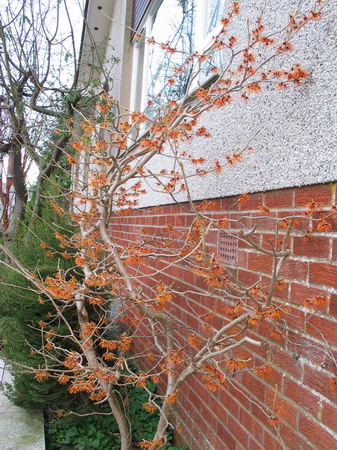
Witch Hazel
Osmanthus & Oenothera
At last year's Gardening Scotland we had two troughs with small Osmanthus plants in them These had come from B&Q the year before and are superb foliage shrubs. They may in time grow to be big brutes but at present they are like little hollies in the troughs. They are tough little things and look like holly. When iced with frost they are very beautiful. After 2 years they are still only 10cm tall.
Osmanthus 'aurea' is golden [naturally!] and Osmanthus 'tricolour' has mottled foliage.
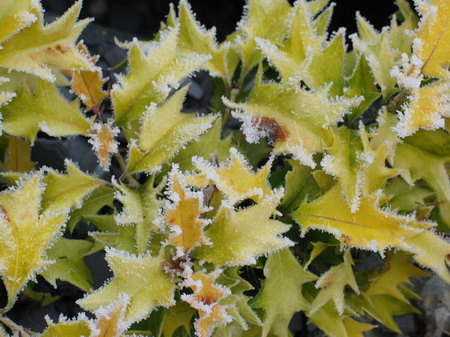
Frost decorating Osmanthus aurea
Soon it will be time for
The SRGC Early Bulb Display [18th February] and
the SRGC Stirling Show [25th March].
Both will be held in the Victoria Hall in Dunblane.
The renowned grower of Small bulbs Janis Ruksans from Latvia will give two lectures at the Bulb Display. The first at 11.00am on Crocus & Corydalis and the second at 2.00pm on 'Hunting for Bulbs in Central Asia's Mountain Places'.
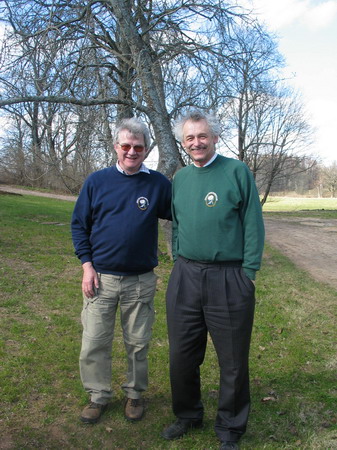
Me with Janis Ruksans
I look forward to welcoming the many SRGC members who will be there. If you have not been before please make an effort and you will be sure to have a terrific day. Here is a taster of what we might see. This field of Corydalis which I photographed in Janis' nursery is extraordinary!
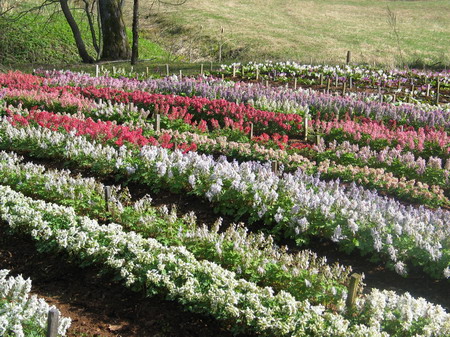
Corydalis solida in Janis Ruksans nursery
^ back to the top ^
|

